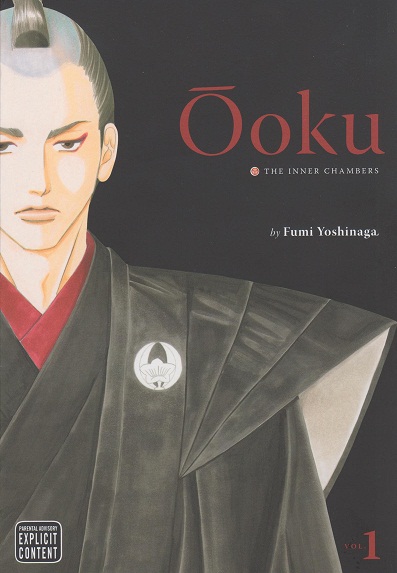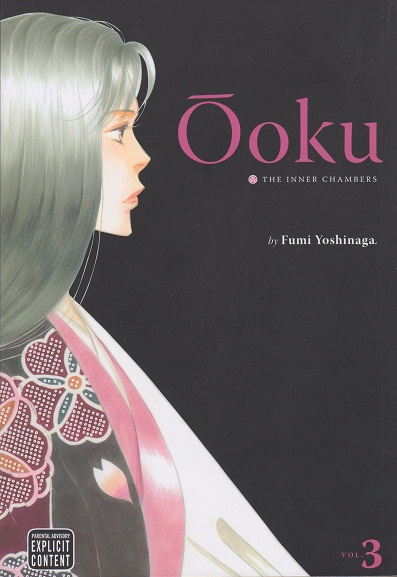 Title: Ōoku: The Inner Chambers
Title: Ōoku: The Inner Chambers
Author: Fumi Yoshinaga
Publisher: Viz Media, on the Viz Signature imprint
Volume: Volumes 1-3 (all currently available), $12.99 each
Vintage: Began in 2005, from Hakusensha in Japan, 2009 from Viz, with volume 3 in April 2010. Volume 4 was in May’s Previews.
Genre: Historical drama, some romance, political intrigue (hooray! my favorite). It’s got a mature rating, for some mild sexual content, and bloody violence (not gory, but people are executed, or forced to commit seppuku).
The story so far: It’s Edo era Japan, and the Tokugawa Shogunate is delicately maintaining its rule. In the time of Shogun Iemitsu, a plague spreads throughout the country. This plague, called the redface pox, strikes males only, and most often young men. Japan’s male population is hit hard by the disease, which has no cure. With their fathers, husbands, brothers, and sons dropping like flies, the women of Japan slowly begin to step up and take control of the country, working the fields, selling wares…ruling the country. When Iemitsu dies of the redface pox, his daughter is secretly brought into the palace and made shogun. The inner chambers of the palace are turned upside down. Rooms once filled with female concubines are filled with young men. Japan closes itself off from the rest of the world, not only to stop the spread of the plague, but to keep the crisis, the loss of their men, a secret from other countries. The palace is closed off from the outside as well, with those within sworn to secrecy, and most never being allowed to leave for the rest of their lives. Within the palace, a new way of life forms. Manly values of power through strength, gruff masculinity, slowly give way to a new way of life where beauty and grace are highly valued. Beautiful young men make their way through the ranks by whatever means necessary, often sleeping their way up, attempting to become grooms of the bedchamber, from which the shogun often chooses a mate. Gaining favor with the shogun means power within the inner chambers, and a chance to father the next heir.
In volume 1, a handsome young man named Mizuno decides to join the Inner Chambers to ease the burden on his struggling family. Through Mizuno’s eyes, we see what the Inner Chambers have become – a world where men fight amongst themselves to gain power within their closed off society. There is extravagance everywhere, from wasted food, to overly decorated clothing; the men of the Inner Chambers are draining the palace coffers dry. The new shogun arrives, Yoshimune, a spirited woman with disdain for the wasteful spending going on in her palace, and she immediately sets about to making sweeping changes, disturbing old traditions and changing the way the men must live. In an effort to discover why these traditions exist, how they came to be in their current forms, the shogun immerses herself in the archives to study the “Chronicle of a Dying Day,” a text that chronicles the history of Japan since the death of Iemitsu, and life in the Inner Chambers.
Volume 2 goes back into the past, when the last male shogun, Iemitsu, died of the redface pox, and his daughter was brought in to produce a Tokugawa heir. To breed with her, a young monk is brought into the palace and forced to revoke his priestly vows. The kindhearted Arikoto is thrust into a cruel world, where only the survival of the Tokugawa Shogunate matters. As both Arikoto and the young shogun, Lady Chie, struggle with being seen as little more than livestock and seed, they somehow find comfort with each other.
That brings us to volume 3. After a year of sharing a bed together, the lady shogun and Arikoto have not produced an heir. Another man is brought into the Inner Chambers, and Arikoto is forced to step aside for the sake of the country. The redface pox continues to ravage the country, and Chie sees the effects first hand on a tour of the city, where men are commodities not for pleasure, but for breeding. In desperation, Arikoto places his young attendant into the service of Chie, unable to stand the succession of new men he has been forced to push onto his love. Meanwhile, Chie is slowly asserting her place on the governing council still run by men, paving the way for future female shoguns.
 Ōoku: The Inner Chambers won the 2009 Osamu Tezuka Cultural [Grand] Prize, and it’s absolutely deserved. Yoshinaga herself was nominated for a 2008 Eisner Award for writing, for her series Flower of Life and The Moon and Sandals. Ōoku is exactly the sort of manga that I love. Beautiful art, excellent story; history, drama, romance, politics…talk about a dream come true. It’s hard for me to find a genuine complaint about the series, except maybe that the character designs can, on occasion, blend together. When all the men are essentially clothed the same, with similar hairstyles, it can be a little confusing to tell them apart. Fortunately the presentation of the manga makes things clear, so it’s rarely an issue. Viz Media decided to color the text up by using an older form of English (like thou, thine, nay, verily, forsooth). Do not let this put you off the title! Once you stop trying to decide if it’s being done correctly (like I can’t help doing, sorry), and just settle into it, you get used to it quickly. So this is me warning you, so that you’re not surprised; it’s not a negative element. It can be a tad funny at times, but Viz is clearly trying to create a certain atmosphere, and I commend them for it, because it was a huge risk.
Ōoku: The Inner Chambers won the 2009 Osamu Tezuka Cultural [Grand] Prize, and it’s absolutely deserved. Yoshinaga herself was nominated for a 2008 Eisner Award for writing, for her series Flower of Life and The Moon and Sandals. Ōoku is exactly the sort of manga that I love. Beautiful art, excellent story; history, drama, romance, politics…talk about a dream come true. It’s hard for me to find a genuine complaint about the series, except maybe that the character designs can, on occasion, blend together. When all the men are essentially clothed the same, with similar hairstyles, it can be a little confusing to tell them apart. Fortunately the presentation of the manga makes things clear, so it’s rarely an issue. Viz Media decided to color the text up by using an older form of English (like thou, thine, nay, verily, forsooth). Do not let this put you off the title! Once you stop trying to decide if it’s being done correctly (like I can’t help doing, sorry), and just settle into it, you get used to it quickly. So this is me warning you, so that you’re not surprised; it’s not a negative element. It can be a tad funny at times, but Viz is clearly trying to create a certain atmosphere, and I commend them for it, because it was a huge risk.
There’s also a lot of really fantastic commentary within the series about the placement and roles of men and women. The redface pox forces a complete reversal of how the country is run, and Yoshinaga excellently illustrates how even in the face of such a disaster, people still try to hold on to their traditions and social standards. I could probably write a whole essay on how the sexes are presented, used, and altered during the story. I won’t, as this is quite long enough, but there’s an awful lot going on in Ōoku that is worth having a good discussion over.
Viz has done an amazing job with the presentation of these books. They’re absolutely gorgeous. Each book is oversized, with inner flaps (that continue the outer cover), and some even have a color page or two at the front. At the back of each volume are extensive liner notes, describing various terminology used within the text, providing historical background, and translation notes. The only complaint I can give Viz here, is that there is a rare page here and there that is printed or cut poorly, slicing the edges (it’s very thin) of the text or art. It doesn’t interfere with anything (you can still read what’s there just fine), but it is a little ugly element in what is otherwise a beautiful presentation. I’m not sure they could really help it, though, because of the way the art fits the page and is bound in the book, without screwing up the format.
With such tiny faults, and the way I instantly took to the title personally, I can do nothing other than heartily recommend Ōoku: The Inner Chambers.
Kris
kristin@comicattack.net
@girlg33k_Kris
A copy of Ōoku: The Inner Chambers volume 3 was provided for review by Viz Media. I loved it and immediately ran out and bought the first two. So thanks, Viz, for giving me a new favorite title to read.



Wow! This sounds like it would make for a great series on HBO or Showtime kind of like Tudors if it was at all possible. Sounds like a fantastic read especially taking place within that time period this looks like another that will possibly end up on my shelf. And here I was trying to shorten my list lol.
You absolutely should pick up a volume. I even managed to get my husband to read this one, which is a rare feat. He was a bit turned off at first, thinking it was some yaoi stuff, but it’s not at all. There are elements in there, because of the setting, but it’s not front and center. It just kind of floats in the background. Once he got past an early scene, he ended up enjoying it. Not as much as I do, as manga just isn’t really his thing, but he moved on to the second volume without any prodding from me. 🙂
Anyway, I loved it. I’d definitely like to see it as an anime, and it probably would make a decent J-Drama. That said, they are actually making a live action film, which is scheduled to come out in October in Japan.
Pingback: Tweets that mention Bento Bako Weekly: Ōoku: The Inner Chambers 1-3 -- Topsy.com
Sounds like a very interesting read Kris. Speech makes a good point too about it being made into a TV series.
Pingback: Manga: Not dead yet « MangaBlog
Pingback: Bento Bako Weekly: Antique Bakery vols. 1&2
Pingback: Bento Bako Lite: September 2010 Previews
Pingback: Bento Bako Weekly: Tezuka’s Ayako
Pingback: Bento Bako Lite: Garden Dreams